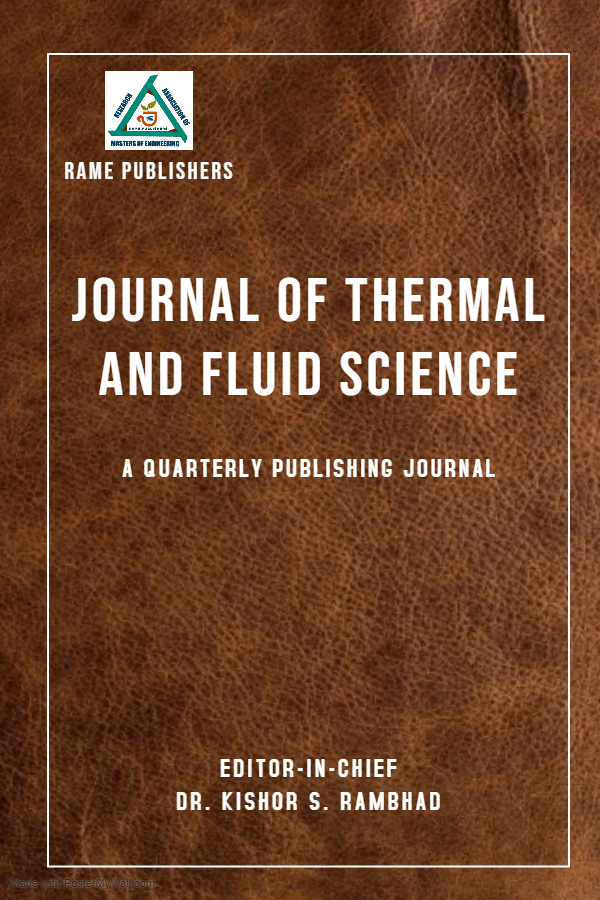Experimental Evaluation on Super- Turbocharged HCCI Engine
Sanskar Sane, Smit Kore, Ojas Gatkal, Bhavik Tamore
Journal of Thermal and Fluid Science
Volume 3: Issue 2, December 2022, pp 59-76
Author's Information
Sanskar Sane1
Corresponding Author
1Department Of Mechanical Engineering, St. John College of Engineering & Management University of Mumbai, India, India
sanskars@sjcem.edu.in
Smit Kore2, Ojas Gatkal2, Bhavik Tamore2
2Department Of Mechanical Engineering, St. John College of Engineering & Management University of Mumbai, India, India
Abstract:-
The impacts of a Twin-charged (turbo + super) technology on a single-cylinder four-stroke diesel engine were explored in this experimental investigation under various operating situations. Because the supercharger burns output power and the turbocharger has turbo-lag, we conducted an experimental investigation on the twin-charged system in this research to solve the drawbacks of both the super and turbocharger. The experiments were carried out on a constant speed engine of 1500 rpm with varied load and compression ratio. The load varies from 0 to 12 kg in 2 kilogramme increments, with a compression ratio of 12-18. The results show that super, turbocharged boost air improves volumetric efficiency significantly, however super and turbocharger diminish thermal efficiency at low and part load for all compression ratios. Furthermore, the engine was updated with a twin-charged (turbo + super) boost to improve thermal efficiency. Tri-charging has a positive impact on engine emissions, lowering CO, HC, and NOX. However, managing the combustion phasing, expanding the operating range, and reducing unburned hydrocarbon and CO emissions remain difficult difficulties in the successful operation of HCCI engines. Massive global research has resulted in significant advances in the control of HCCI combustion.Index Terms:-
Turbocharging, HCCI Engine, engine emissions, thermal efficiency .REFERENCES
- S: Onishi, S. Hong Jo, K. Shoda, P Do Jo, S. Kato: ”Active Thermo-Atmosphere Combustion (ATAC) – A New Combustion Process for Internal Combustion Engines”, SAE790501
- P.Duret, S.Venturi: ”Automotive Calibration of the IAPAC Fluid Dynamically Controlled Two-Stroke Combustion Process”, SAE960363
- M. Noguchi, Y. Tanaka, T. Tanaka, Y. Takeuchi: ”A Study on Gasoline Engine Combustion by Observation of Intermediate Reactive Products during Combustion”, SAE790840
- N. Iida: ”Combustion Analysis of Methanol-Fueled Active Thermo-Atmosphere Combustion (ATAC) Engine Using a Spectroscopic Observation” SAE940684
- Y. Ishibashi, M. Asai: ”Improving the Exhaust Emissions of Two-Stroke Engines by Applying the Activated Radical Combustion”, SAE960742
- R. Gentili, S. Frigo, L. Tognotti, P. Hapert, J. Lavy: ”Experimental study of ATAC (Active ThermoAtmosphere Combustion) in a Two-Stroke Gasoline Engine”, SAE 970363
- A. Hultqvist, M. Christensen, B. Johansson, A. Franke, M. Richter, M. Aldén: ”A Study of the Homogeneous Charge Compression Ignition Combustion Process by Chemiluminescence Imaging”, SAE1999-01-3680
- P. Najt, D.E. Foster: ”Compression-Ignited Homogeneous Charge Combustion”, SAE830264
- VW Khond, K Rambhad, V Shahadani, New diesel-neem biodiesel blend (D75NB25) containing nano iron oxide, silicon dioxide and zinc oxide for diesel engine: An experimental investigation, Materials Today: Proceedings 47, 2701-2708
To view full paper, Download here
To View Full Paper
For authors
Author's guidelines Publication Ethics Publication Policies Artical Processing Charges Call for paper Frequently Asked Questions(FAQS) View All Volumes and IssuesPublishing with




